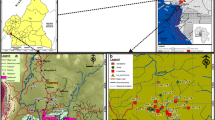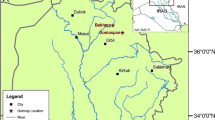Summary
The limestones of the Wadi Nasb Formation of the uppermost Lower Cambrian of Jordan are under- and overlain by massive sandstones of a near-shore facies. Facies analysis is based on samples from an outcrop at the northeastern shore of the Dead Sea and two oil test wells in the Wadi Sirhan Depression in eastern Jordan. Limestones were deposited in the shallow sea and within the coastal tidal area. Cyanobacteria, algae, echinoderms, trilobites and hyoliths have contributed the bulk of the carbonate and phosphatic material composing the Wadi Nasb limestone. Fine-grained facies types are composed of peloidal carbonate muds with laminar and nodular algal and cyanobacterial mats. They formed within a quiet tidallagoonal environment. The coarse grained facies types consist of carbonate sands with layers of sheell debris deposited in crossbeds in an environment with a rich endobenthic fauna. Here most particles were coated by cyanobacterial crusts. Ooids, oncoids and various coated grains are present. Consolidated sediments were commonly eroded within or near to this environment and their remains were integrated within the sands. Diagenesis is reconstructed step by step with deposition, first cementation, aragonite dissolution, compaction, pore filling, formation of pressure solution, growth of dolomite and anhydrite within the calcitic limestone and final fissure formation and filling.
Similar content being viewed by others
References
Bandel, K. (1981): New stratigraphical and structural evidence for lateral dislocation in the Jordan Rift Valley connected with a description of the Jurassic rock column in Jordan.—N. Jb. Geol. Paläont. Mh.,1981, 271–308, Stuttgart
— (1986): The reconstruction of ‘Hyolithes kingi’ as annelid worm from the Cambrian of Jordan.—Mitt. Geol. Paläon. Inst. Univ. Hamburg,61, 35–101, Hamburg
Bandel, K. &Khoury, H. (1981): Lithostratigraphy of the Triassic in Jordan.—Facies,4, 1–26, Erlangen
Bender, F. (1968): Geologie von Jordanien.—Beiträge zur Regionalen Geologie der Erde7, (212 pp., Berlin (Borntraeger)
— (1975): Geology of the Arabian Peninsula.—Jordan. U.S. Geol. Surv. Prof. Paper No.560-I, U.S. Government printing office, Washington.
Blake, G.S. (1936): The stratigraphy of Palestine and its building stones.—133 pp., Jerusalem (Printing and Stationary office)
Blankenhorn, M. (1912): Naturwissenschaftliche Studien am Toten Meer und im Jordantal.—478 pp., Berlin (Friedländer)
— (1931): Geologie Palästinas nach heutiger Auffassung.—Z. d. deutsch. Palästina-Vereines,54, 3–50, Leipzig
Bromley, R.G. (1965): Studies in the lithology and conditions of sedimentation of the chalk rock and comparable horizons.— Thesis, Univ. London, unpubl., 355 pp.
Burdon, D.J. (1959): Handbook of the Geology of Jordan to accompany and explain the three sheets of the 1∶250,000 Geological Map East of the Rift by A.M. Benham & Co., Colchester
Carozzi, A. V. (1957): Contribution de l’etude des proprietes geomètriques des oolithes—l’exemple du Grand Lac Sale, Utah, USA.—Inst. Nat. Genevois Bull.,58, 1–52, Genève
Dunham, R.J. (1962): Classification of Carbonat rocks according to depositional texture.—In:Ham, W.E. (Hrsg.): Classification of carbonate rocks.—Amer. Assoc. Petrol. Geol. Memoir,1, 108–121, Tulsa
Flügel, E. (1982): Microfacies Analysis of Limestones.—633 pp., Heidelberg (Springer)
Folk, R.L. (1962): Spectral subdivison of Limestone types.—In:Ham, W.E. (Hrsg): Classification of carbonate rocks.—Amer. Assoc. Petrol. Geol. Memoir,1, 62–84, Tulsa
Hull, E. (1886): Memoir on the physical geology and geography of Arabia Petraea, Palestina, and adjoining districts, with special reference to the mode of formation of the Jordan-Arbah depression and the Dead Sea. Survey of Western Palestine.—145 pp., London (Bentley)
Irwin, M.L. (1965): General theory of epiric clear water sedimentation. —Bull. Amer. Ass. Petrol. Geol.,49, 445–459, Tulsa
King, W.B.R. (1923): Cambrian Fossils from the Dead Sea.—Geol. Mag.,60, 507–514, London
Leighton, M.W. &Pendexter C (1962): Carbonate rock types.— Amer. Assoc. Petrol. Geol. Memoir,1, 33–61, Tulsa
Lloyd, J.W. (1969): The hydrogeology of the southern Desert of Jordan.—UNDP/FAO. 212: Investigastions of the sandstone aquifers of East Jordan.—Tech. Rep. No. 1; Rome
Morton, D.M. &Wetzel, R. (1959): Contribution a la Geologie de la Transjordanie. Notes et Memoires sur le Moyen-Orient.—In:Dubertret, M.L. (Hrsg.): Contributions a la Geologie de la Peninsule Arabique 7.-95-188, Paris (Museum Nat. d’Hist. Natur.)
Picard, L. (1942): New Cambrian fossiles and Paleozoic problematica from the Dead Sea and Arabia.—Bull. Geol. Dept. Hebrew Univ.,4, 1–18. Jerusalem
Plumley, W.Y. Risley, G.A., Graves, R.W. &Kaley, M.E. (1962): Energy index for limestone interpretation and classification.— Amer. Assoc. Petrol. Geol. Memoir,1, 85–107, Tulsa
Powell, J.H. (1988): The geology of the Karak area, map sheet No. 3/52, Hashemite Kingdom of Jordan.—Natural Resources Authority, National geological mapping project, Bull.8, 172 p., Amman
Quennell, A.M. (1951): The Geology and mineral resources of (former) Transjordan.—Colonical Geology and Mineral Resources,2, 82–115, London
Quennell, A.M. (1956): Geological Map of Jordan (East of the Rift Valley). 1∶250.000, Sheet Amman, Sheet Kerak, Sheet Maan, Amman
Richter, R. &Richter, E. (1941): Das Kambrium am Toten Meer und die älteste Tethys.—Abh. Senckenb. Natur. Ges., 460, 1–50, Frankfurt
Selley, R.C. (1970): Ancient sedimentary environments: a brief survey.—237 pp., London (Chapman & Hall)
— (1972): Diagnosis of marine and non-marine environment from Cambro-Ordovician sandstones of Jordan.—J. Geol. Soc.,128, 135–150, London
Shinaq, R. (1990): Mikrofazielle Untersuchungen kambrischer, triassischer und jurassischer Karbonatgesteine Jordaniens.— Dissertation Univ. Hamburg, 196 pp.
Wetzel, R. (1947): Stratigraphic sections of Jordan Valley and Dead Sea, Pt. I.—Unpubl Report, Petrol. Dev. (Transjordan) Ltd., Arch. Natural Resourc. Authority, Amman
Wetzel, R. &Morton, D.M. (1959): Contribution a la geologie de la Transjordanie.—In:Dubertret, M.L. (Hrsg.): Contributions a la Geologie de la Peninsule Arabique 7.-95-188, Paris (Museum Nat. d’Hist. Natur.)
Wilson, J.L. (1975): Carbonate facies in geologic history.—471 pp., Berlin (Springer)
Author information
Authors and Affiliations
Rights and permissions
About this article
Cite this article
Shinaq, R., Bandel, K. Microfacies of Cambrian Limestones in Jordan. Facies 27, 263–283 (1992). https://doi.org/10.1007/BF02536817
Received:
Revised:
Issue Date:
DOI: https://doi.org/10.1007/BF02536817




